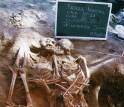|

Press Release 06-019
Excavated Teeth Likely Came from First Africans Brought to the New World

Europeans may have imported slaves in the 1500s
January 31, 2006
Forensic details obtained from human teeth excavated from a church graveyard in Mexico suggests Europeans brought slaves from Africa to the New World as long ago as the late 1500s to work as servants and on the docks of coastal Central America. According to a report to be published in an upcoming issue of the American Journal of Physical Anthropology, the teeth came from people born in Africa and who were probably among the first slaves brought to the Americas.
"It does mean that slaves were brought here almost as soon as Europeans arrived," said T. Douglas Price of the University of Wisconsin-Madison.
Price and coworker James H. Burton of UW-Madison, and Vera Tiesler of the Autonomous University of the Yucatan, measured a radioactive substance known as strontium in teeth recovered from an early colonial burial ground in Campeche, Mexico, located on the gulf shore of the Yucatan Peninsula. Strontium isotopes are normally found in the soil, but make their way into the food supply when they are dissolved and taken up by plants. Because the substance concentrates in teeth and bones of people and animals that eat the plants, strontium has become a reliable marker not only of the age of human remains but also of their geographic origin.
The National Science Foundation funded the work.
Radioactive strontium in teeth is particularly useful for determining birthplace, because teeth form during gestation and early childhood. The type of strontium found in teeth mirrors that deposited in the bedrock of the area where a person was born. By comparing the isotopes in teeth recovered from the graveyard with known strontium values for geologic regions around the world, the scientists were able to determine if the individuals were born in Africa or the New World.
The values Price and his coworkers found in the teeth "coincides closely with the region inland from the Gold Coast," the report says, "infamous as the center of the African slave trade during the late 16th and 17th century."
"These individuals are likely to be among the earliest representatives of the African Diaspora in the Americas, substantially earlier than the subsequent, intensive slave trade of the 18th century."
Read the University of Wisconsin press release.
-NSF-

Media Contacts
Leslie Fink, National Science Foundation (703) 292-5395 lfink@nsf.gov
Terry Devitt, University of Wisconsin (608) 262-8282 trdevitt@wisc.edu
Program Contacts
John Yellen, National Science Foundation (703) 292-8759 jyellen@nsf.gov
Principal Investigators
T. Douglas Price, University of Wisconsin (608) 262-2575 tdprice@wisc.edu

The National Science Foundation (NSF) is an independent federal agency that supports fundamental research and education across all fields of science and engineering. In fiscal year (FY) 2009, its budget is $9.5 billion, which includes $3.0 billion provided through the American Recovery and Reinvestment Act. NSF funds reach all 50 states through grants to over 1,900 universities and institutions. Each year, NSF receives about 44,400 competitive requests for funding, and makes over 11,500 new funding awards. NSF also awards over $400 million in professional and service contracts yearly.
 Get News Updates by Email Get News Updates by Email
Useful NSF Web Sites:
NSF Home Page: http://www.nsf.gov
NSF News: http://www.nsf.gov/news/
For the News Media: http://www.nsf.gov/news/newsroom.jsp
Science and Engineering Statistics: http://www.nsf.gov/statistics/
Awards Searches: http://www.nsf.gov/awardsearch/
| 



